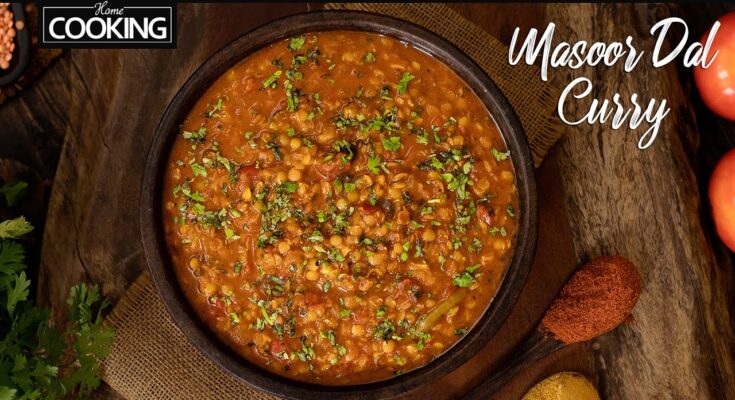Dahl Recipe: Dahl, also spelled as dal or daal, is a hearty lentil-based dish originating from the Indian subcontinent. It’s a staple in many Indian homes and comes in various styles and flavors depending on the region. The word “dahl” actually refers to both the ingredient (lentils) and the final cooked dish. Whether you’re a seasoned lover of Indian cuisine or just exploring, dahl offers a rich, earthy comfort food experience that is both nourishing and satisfying.
Made from lentils simmered with spices, onions, garlic, and often tomatoes, dahl is simple yet deeply flavorful. What makes it so appealing is its versatility. It can be thin and soupy or thick and stew-like, depending on your preference. It’s often served with rice or flatbreads like roti or naan, and it can be made spicy or mild depending on the spice level you like.
Why You’ll Love This Recipe
This step-by-step dahl recipe is perfect for beginners and seasoned cooks alike. It’s easy to follow, doesn’t require fancy ingredients, and results in a meal that’s both filling and packed with flavor. Not to mention, it’s budget-friendly, vegan, gluten-free, and rich in protein and fiber. This is a dish you’ll want to make again and again—especially once you see how customizable it is.
Plus, making dahl at home gives you full control over the flavors and spice levels, so you can tailor it to your exact taste. And once you get the basic technique down, you’ll find it incredibly fun to experiment with different lentils, vegetables, and spices. Whether you’re cooking for one or feeding a family, this dahl recipe is a winner.
Ingredients for the Perfect Dahl
Main Ingredients
Here’s what you’ll need to make a delicious, basic dahl:
- Lentils (1 cup): Yellow split peas (chana dal), red lentils (masoor dal), or moong dal work best.
- Water (3-4 cups): Adjust based on the consistency you like.
- Onion (1 medium): Finely chopped.
- Tomato (1 medium): Diced.
- Garlic (3-4 cloves): Minced.
- Ginger (1-inch piece): Grated or minced.
- Turmeric Powder (1/2 tsp): For color and health benefits.
- Salt (to taste): Essential for seasoning.
- Oil or Ghee (2-3 tbsp): Ghee adds more depth of flavor, but use oil for a vegan option.
- Mustard Seeds (1/2 tsp): Adds a nutty flavor.
- Cumin Seeds (1/2 tsp): Classic in Indian cooking.
- Green Chili (1, optional): For heat.
Optional Add-ins for Extra Flavor
- Fresh Coriander Leaves (Cilantro): For garnish.
- Red Chili Powder (1/2 tsp): For more heat.
- Curry Leaves (5-6): If you can find them, they add great aroma.
- Asafoetida (Hing, a pinch): Adds umami.
- Garam Masala (1/2 tsp): A finishing spice blend.
These ingredients come together to create a dish that’s deeply satisfying and aromatic. If you don’t have all the spices, don’t worry—you can still make a flavorful dahl with just the basics.
Preparing for the Cooking Process
Soaking the Lentils
This step depends on the type of lentils you’re using. Red lentils don’t need soaking and cook quickly, while chana dal and moong dal benefit from a 1-2 hour soak in warm water. Soaking not only speeds up cooking time but also helps improve digestibility.
To soak, simply place your lentils in a bowl, cover with water, and let them sit. Drain and rinse before cooking. This step ensures they cook evenly and retain their texture without turning mushy.
Prepping Spices and Aromatics
Before you start cooking, it’s helpful to prep everything ahead of time. Finely chop onions, garlic, and tomatoes. Grate or mince the ginger. Measure out your spices and set them aside in a small bowl.
Prepping your ingredients before turning on the stove helps streamline the cooking process and ensures nothing gets burned or forgotten. Trust me—once you start cooking and the aroma hits, you won’t want to pause for chopping.
Step-by-Step Cooking Instructions
Step 1: Cooking the Lentils
Place the lentils in a pot with 3-4 cups of water and a pinch of turmeric. Bring to a boil, then reduce to a simmer. Skim off any foam that forms on the top. Cook until the lentils are tender—about 20-30 minutes, depending on the type. Stir occasionally and add more water if needed.
Alternatively, you can use a pressure cooker or Instant Pot to reduce cooking time significantly. In a pressure cooker, lentils usually take just 5-7 minutes.
Once cooked, mash the lentils slightly with the back of a spoon for a creamy texture. Keep it simmering on low while you prepare the tempering.
Step 2: Making the Tadka (Tempered Spices)
This is where the magic happens. Heat oil or ghee in a small pan over medium heat. Add mustard seeds and let them pop. Then add cumin seeds, minced garlic, ginger, and chopped onions. Sauté until golden brown and fragrant.
Next, add chopped tomatoes, green chili, and any additional spices like red chili powder or curry leaves. Cook until the tomatoes break down and everything melds together into a rich, spiced paste.
Step 3: Combining Everything
Now that your tadka (tempered spice mix) is ready, it’s time to bring it all together. Carefully pour the sizzling tadka into the pot of simmering lentils. You’ll hear a satisfying sizzle—don’t be alarmed, that’s the flavor infusion in action!
Once the tadka is in, stir well to ensure all the spices and aromatics are evenly distributed throughout the lentils. This step transforms the dahl from a basic lentil stew into something extraordinary. Allow the combined mixture to simmer together for 5–10 minutes so the flavors have time to develop and blend fully.
You can adjust the consistency at this point. If you like your dahl more like a soup, add a bit of hot water. If you prefer a thicker stew-like texture, let it simmer a bit longer with the lid off to reduce.
Taste and adjust seasoning—add salt, a pinch more chili powder if needed, or a squeeze of lemon juice for brightness. Trust your palate here; a well-seasoned dahl should be warm, slightly spicy, earthy, and comforting.
Step 4: Simmering for Perfection
Don’t rush this final step. Simmering the dahl allows it to thicken naturally and lets the spices meld beautifully. Keep the heat low and cover the pot partially to prevent splattering. Stir occasionally to avoid sticking.
During this phase, the lentils soak up the flavors of the tadka and deepen in color and aroma. This is also a great time to add in extra ingredients if you like—a handful of spinach, cooked chickpeas, or even some coconut milk for a creamy twist.
After about 10 more minutes of gentle simmering, your dahl should have a silky texture and rich taste. The house will be filled with mouthwatering aromas, and your comfort food masterpiece will be ready to serve.
Serving Suggestions
Best Sides to Serve with Dahl
One of the best things about dahl is how well it pairs with other dishes. The most classic combo is dahl with steamed basmati rice, often referred to as “dal chawal.” The rice absorbs the flavors of the dahl perfectly and makes for a satisfying, filling meal.
Here are some great serving ideas:
- Naan or Roti: Great for scooping up the dahl.
- Jeera (Cumin) Rice: Adds a subtle aromatic layer.
- Pickles and Papadam: Traditional Indian condiments that add crunch and tang.
- Sautéed Greens or Vegetables: A healthy side to balance the richness of dahl.
Dahl is also great as part of a larger thali (Indian-style platter), alongside curries, chutneys, and vegetable sides.
Garnishing Tips
Garnishes don’t just make the dish look pretty—they add texture and flavor too. Here are some ideas to finish off your dahl:
- Fresh cilantro (coriander) leaves: Bright and herbaceous.
- Sliced green chilies: For a kick of heat.
- A swirl of coconut cream or yogurt: Adds a creamy contrast.
- Toasted cumin powder or garam masala: Sprinkle on top for an aromatic finish.
- Fried garlic chips: A crunchy topping that brings extra depth.
Garnish just before serving to keep everything fresh and vibrant. A beautiful bowl of dahl, garnished and steaming, is hard to resist!
Nutritional Benefits of Dahl
Protein-Packed and Nutritious
Dahl isn’t just delicious—it’s incredibly good for you too. Lentils are a powerhouse of plant-based protein, making them an essential part of vegetarian and vegan diets. Just one serving of dahl can provide around 15–20 grams of protein, depending on the type of lentils used.
Besides protein, lentils are loaded with:
- Fiber: Great for digestion and keeps you full longer.
- Iron: Helps boost energy and supports red blood cell production.
- Folate and B-vitamins: Important for brain health and energy metabolism.
- Magnesium and Potassium: Support heart health and regulate blood pressure.
What makes dahl even better is that it’s low in fat and has zero cholesterol. When paired with rice or bread, it becomes a complete protein, which means you’re getting all essential amino acids in one meal. That’s pretty amazing for a humble bowl of lentils!
If you’re watching your calories, dahl is a perfect fit. It’s hearty and filling, so you’re less likely to snack later, helping you maintain a balanced diet.
Great for Digestion
One of the standout health benefits of dahl is its high fiber content, especially when made with whole lentils. Fiber plays a crucial role in maintaining digestive health by promoting regular bowel movements and supporting a healthy gut microbiome.
Moreover, the spices commonly used in dahl—like turmeric, cumin, ginger, and garlic—aren’t just for flavor. They each have their own digestive benefits:
- Turmeric: Anti-inflammatory and helps reduce bloating.
- Cumin: Stimulates digestive enzymes.
- Ginger: A natural remedy for indigestion and nausea.
- Garlic: Supports gut health and boosts immunity.
These ingredients work together to create a dish that’s not only easy on your stomach but actually supports digestive wellness. It’s comfort food that loves you back.
FAQs about Dahl Recipe
Can I make dahl with canned lentils?
Yes, you can! Canned lentils are already cooked, so you can skip the boiling step. Just rinse them well and add them after making the tadka. Let everything simmer together for 10–15 minutes to develop the flavor.
How long does dahl last in the fridge?
Dahl stays fresh in the refrigerator for up to 4–5 days when stored in an airtight container. Reheat on the stovetop or microwave, and add a splash of water if it thickens too much.
Can I freeze dahl?
Absolutely. Dahl freezes beautifully. Let it cool completely, then store in freezer-safe containers or bags for up to 3 months. Thaw in the fridge overnight and reheat thoroughly before serving.
What lentils are best for dahl?
Red lentils (masoor dal) are quick-cooking and creamy. Yellow split peas (chana dal) and moong dal have a nuttier flavor and hold their shape better. You can mix different lentils for a unique texture and taste.
Is dahl gluten-free?
Yes, dahl is naturally gluten-free. Just be sure that any spices or pre-packaged ingredients you use don’t contain gluten-based additives or thickeners.
Conclusion
Dahl is more than just a meal—it’s a soulful experience in a bowl. With its rich flavors, nutritional benefits, and comforting warmth, it’s no surprise this humble dish is beloved across generations and cultures. Whether you’re cooking it for the first time or have been enjoying it for years, following this step-by-step guide will help you make the perfect dahl every single time.
Simple ingredients, a bit of prep, and the magic of Indian spices—that’s all it takes to whip up something that’s hearty, healthy, and absolutely delicious. It’s the kind of dish that brings people together, makes you feel at home, and fills your kitchen with the aromas of love and tradition.
So next time you need a cozy, budget-friendly, and satisfying dish, you know what to cook. Trust the process, play with the spices, and enjoy every spoonful.



